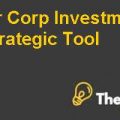Back to the Roots Case Case Study Solution
Introduction
Back to the Roots Corporation is a dynamic and innovative corporation that has impressed a position for itself in the field of sustainable and environmental products (Elizabeth et al., 2018). The company is determined by a mission to reconnect people with their food, the environment, and each other. At Back to the Roots the corporation’s mission is to inspire a new generation to encourage a deeper understanding of where their food comes from and to raise a stronger connection to nature. The company believes in the power of sustainable and regenerative practices to create a healthier and more harmonious world.
The company's product portfolio includes ready-to-grow indoor gardening kits and ready-to-eat products like their flagship biodynamic cereal and an upcoming snack product. These product categories, while aligned with the mission of reconnecting people to their food sources, represent significantly different markets, consumer behaviors, and distribution channels (Kaplan et al., 2012).
Problem Statement
The corporation faces the challenge of understanding and navigating the dynamics of consumer preferences and market trends in both the ready-to-grow and ready-to-eat segments. The competitive landscape, consumer demands, and potential partnerships require careful consideration to ensure sustained growth and relevance.
Situation Analysis
From the given case study we analyze the information on that basis we design some alternatives that can increase the value of the organization. The Core values of the organization are also identified.
Alternatives for Back to Roots
Focus on Core Competencies
The company must consider concentrating efforts on the ready-to-grow (RTG) portfolio, which has already gained traction and has a presence in various channels. Strengthen the position in the indoor gardening movement, potentially expanding the range of crops or exploring new partnerships within this segment (Kempster et al., 2019).
Optimize Product Mix
The company should evaluate the performance of each product in the RTG and ready-to-eat (RTE) portfolios. Identify high-performing products and potentially discontinue or reposition underperforming ones. Given the success of indoor gardening kits for schools, consider expanding educational partnerships or creating specialized products for educational purposes.
Market Expansion
The company must explore new geographical markets for both RTG and RTE products. Identify regions with a growing interest in sustainability and gardening. Leverage partnerships with major retailers to expand the presence of BTTR products on store shelves, especially in channels like Home Depot and Target.
New Product Launch Strategy
The company must assess the potential risks and benefits of launching the new snack product. Consider market demand, competition, and the company's capability to handle the supply chain and distribution challenges. If launching the snack product aligns with market trends and consumer demands, develop a strategic plan for its introduction and promotion.
Balancing Emotional and Rational Choices
The company should try to find a balance between emotional attachment to certain products (e.g., RTE snacks) and rational business decisions. Consider the long-term sustainability and profitability of each product category. Ensure that decisions align with the company's overall mission and values while meeting financial objectives.
Partnership Considerations
Companies must evaluate potential partnerships with large CPG companies carefully. Assess the impact on distribution and market reach versus the risk of losing control over the company's identity and values. Negotiate partnerships that align with Back to the Roots' vision and values, ensuring that the collaborations enhance rather than compromise the company's DNA.
Continuous Learning and Adaptation
Embrace a mindset of continuous learning, similar to the experience gained from launching the first mushroom kit. Apply lessons learned to adapt marketing and sales strategies to new products and partnerships.
These alternatives are designed to help Back to the Roots Corporation navigate the complexities of product portfolios, market expansion, and partnership opportunities while staying true to its mission and values. The company should carefully analyze market trends, consumer behavior, and internal capabilities before making strategic decisions.
Core Values
Sustainability
The company is committed to creating products and solutions that minimize environmental impact and promote sustainable living (Urde, 2003).
Innovation
Constantly pushing the boundaries of creativity, we strive to bring innovative and unique products to the market that enhance the lives of our customers.
Education
We believe in the power of knowledge to drive positive change. Our commitment to education is reflected in our efforts to inform and engage communities on topics related to food, agriculture, and sustainability.
Product Portfolio
Back to the Roots Corporation specializes in a diverse range of products designed to promote sustainable living. Our flagship products include 2000 units in schools and 5000 units in stores. Each is carefully crafted to embody our commitment to quality, sustainability, and innovation..........
Back to the Roots Case Case Study Solution
This is just a sample partial case solution. Please place the order on the website to order your own originally done case solution.












